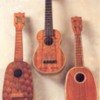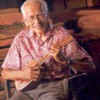In 1879 three cabinetmakers from Madeira-Manuel Nunes, Augusto Dias and Jose do Espirito sailed from |Madeira to Oahu. In the sugar plantation where they worked other Portugese immigrants had introduced a smaller version of a guitar, the machete de braca, to fellow labourers. Nunes, Dias and Espirito replicated the instrument, and from their adaptations evolved the modern Hawaiian ukulele.
Among Nunes proteges was Samuel Kailakaliilii Kamaka, one of the first Hawaiians to become proficient at playing the strings. Sam played not only ukulele but also guitar, upright bass and violin.
Kamaka applied his guitar-making knowledge to create a biggrer sound, he built an ukulele with an oval- shaped body, a departure from the standard figure eight. "It looks like a pineapple," an artist friend told Sam. "I'll paint it." That was in 1926. Two years later the patented "pineapple ukulele" became Kamaka's signature model and the cornerstone of the Kamaka legacy. By the late 30's ,Kamaka was the only Hawaiian ukulele maker still in business.
In 2010, the 1926 pineapple ukulele still delivers the mellow tone and distinct resonance it did 84 years ago.
Samuel Kamaka's craft was all about giving form to function.His designs produced the sound people identify with the Hawaiian ukulele. Quality was so important to the patriach that on his deathbed in 1953, he admonished his sons, "Don't you dare ruin the family name by making junk."
Sam,Jr. and Fred incorporated Kamaka Hawaii in 1968 and perpetuated the good name of their father, who was introduced posthumously into the Ukulele Hall of Fame in 2000.
Today the company is run by a third generation of Kamakas: Sam, Jr.'s sons Chris and Casey, and Fred's sons Fred,Jr.. The grandsons continue to adhere to Samuel's exacting standards, and a Kamaka family member personally inspects each instrument before it's considered finished.
Attachments
Original Post




